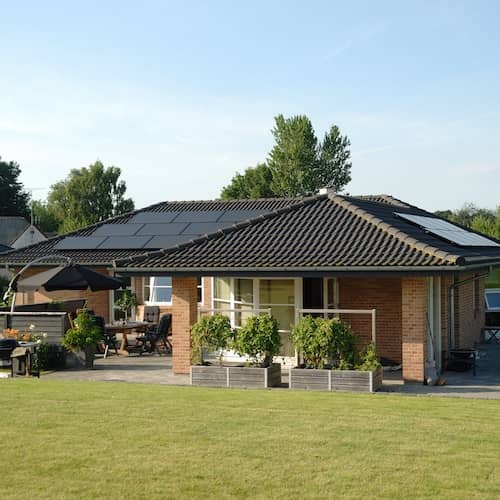Green architecture: What is it, and what are its goals?
Contributed by Tom McLean
May 5, 2025
•6-minute read
Green architecture is an approach to designing structures and homes to have less of an impact on the environment. Every homeowner today can find ways to add green elements to their home.
In the recent past, green architecture was common. This was because people hadn’t developed technology that could harm the environment. Today, this technology can help us create energy-efficient homes. Without giving up the luxuries of modern life, it’s possible to have the best of both worlds and live in green houses.
But what exactly is green architecture, and why is it so important? Learn more about its history and how you can use it today.
What is green architecture, and what is its purpose?
Green architecture is meant to reduce humans’ impact on the environment. It uses sustainable building materials and energy sources to build structures that are healthy and comfortable for its inhabitants. Some houses are built green, while others have green elements added through renovation.
“Our living environments profoundly impact our health and social equity,” says Cassy Aoyagi, president of the sustainable landscaping company FormLA Landscaping, also a board member of the U.S. Green Building Council’s Los Angeles chapter. “We now have the know-how to create living environments that facilitate our health and positively impact the broader environment.”
Green architecture terms to know
When talking about green architecture, you might hear some unfamiliar terms. Here is a quick guide to tell them apart.
- Sustainable architecture: Sustainable architecture looks at the long-term environmental, social, and economic impact of a building. Green architecture focuses on the environmental part.
- Energy efficiency: Energy-efficient homes require less energy to heat, cool, and power. A home can be energy-efficient without being fully green.
- Net-zero homes: Net-zero homes, sometimes called zero-energy homes, have renewable energy systems. They produce as much energy as they use. While the ideal green home is also net zero, it doesn’t have to be.
A brief history of green architecture
Green architecture has been around for as long as humans have built structures. For most of our history, builders used natural lighting and ventilation for light and temperature control. Homes were built with this in mind using natural and sustainable materials.
As technology advanced and people began moving into urban centers, builders started using materials and techniques that could damage the environment. Buildings in dense city settings often consume a lot of energy because they depend on electricity and air conditioning instead of natural light and ventilation.
Today, we are more aware of our carbon footprint, and many buildings are built with energy efficiency in mind. Buildings that meet a certain level of energy efficiency are certified by LEED, or Leadership in Energy and Environmental Design, a green building standard used worldwide.
Characteristics of green architecture
So, what makes a building green? Some characteristics might surprise you, and many might be within your reach.
“Sometimes people think of a green building as one that has solar panels on it, but it’s much more than that,” says Jim Schneider, a writer and LEED-accredited professional who works in the building design and construction industry. “The best sustainable designs seek to reduce waste, conserve energy and resources, and offer high performance and function to occupants and the community. There are lots of ways to get to those goals, and the challenge and opportunity for architects is coming up with the right mix of materials, building products and systems that work together with a smart design to deliver an efficient, high-performing building.”
There are many ways to create green homes. Some are easier to do than others, but there are opportunities homeowners of all types can take to make their homes more efficient and environmentally friendly.
Alternative energy sources
Adding renewable energy resources is a popular method of “greening” one’s home. A recent study by Rocket Mortgage shows that 25.3% of homeowners want solar energy, while 12.6% are interested in a gray water system.
- Solar panels: Solar panels are highly sought after in today’s housing market. These panels turn sunlight into electricity. Solar panels often are installed on the roof, but they can be put anywhere on your property to maximize seasonal sunlight exposure. Solar loans, tax credits, and other incentives are available to homeowners who want to install solar panels.
- Wind turbines: Wind power can be harnessed by small turbines created for homeowners. Certain regions are best for wind energy, and these turbines are most successful in rural areas with notable wind resources.
- Biomass: Biomass is condensed organic material, such as wood, leftover field crops, or switchgrass, that generates heat and electricity. The biomass must be ethically harvested for it to be considered green.
- Geothermal systems: Geothermal systems use natural heat emanating from beneath the Earth’s surface. They use less energy and cost less than traditional HVAC systems. Because it depends on hydrothermal activity and requires drilling, specific locations on Earth have better access to geothermal systems than others.
Energy conservation
Most homeowners can take relatively simple steps to reduce their energy use.
- Electricity: Energy Star-certified appliances, lightbulbs, heaters, furnaces, and air conditioning units can use less energy. For example, air conditioning can be a real drag on electricity usage, with 19% of all residential electricity going toward it. Choosing an Energy Star air conditioner and improving household ventilation can cool your home with less energy and save you money.
- Heat: Conserving heat is on most homeowners’ minds every winter, even in warmer regions. Rocket Mortgage’s homeowner preference study in 2024 shows that 35.7% of homeowners want energy-efficient windows. Green architecture also uses high-performance insulation made of cellulose, fiberglass, or sheep’s wool. If you have a sense of flair, a green roof — one all or partially covered in vegetation — can provide insulation and a stylish look.
- Water: Collecting and filtering rainwater for everyday use is easy, but review and follow your state’s regulations. Investing in a gray water system, which redirects and filters much of your household’s used water, is another way to use less water and save money.
- Ventilation: Green architecture relies on natural ventilation systems, using wind and buoyancy to bring fresh air into a building and act as a natural air purifier. If you plan on building an addition to your home, consider window placement and natural ventilation.
Use of sustainable and recycled materials
When a green house is built from the ground up, nontoxic, recycled, and sustainable materials are used. These materials have a low carbon footprint and are healthier for humans and the environment. Green building materials are green from their creation, while recycled glass, concrete, and rubber tires are other sustainable options. Some examples of green materials are:
- Reclaimed wood
- Bamboo
- Cork
- Straw bales
- Cob
- Clay plaster
- Sheep’s wool
- Peat or earth blocks
A green home isn’t limited to these materials, and you can use these alongside more common materials such as concrete and metal. If you plan on renovating your home, consider ways to incorporate alternative materials.
Where can I find green homes?
If buying a green home is a priority, your real estate agent can help you find the best options. Even if they aren’t an expert in green homes, they should be able to help.
Finding LEED-accredited architects and designers is a good place to start if you’re building a new home instead of buying one.
How can I pay for a green home?
Paying for a green home can be within your reach just as paying for another home. Besides the more common mortgages, additional financing options are available for buying or remodeling green homes.
- Federal Housing Administration loan energy-efficient mortgage: If you’re already planning on an FHA loan, consider their energy-efficient mortgage. It might cover costs upfront or contribute a certain percentage of your home value to add green features to a new home. Some examples of what might be covered include renewable energy systems, insulation enhancements, and window replacements.
- Veterans Affairs energy-efficient mortgage: If you’re eligible for a VA loan, you can apply for their energy-efficient mortgage. This gives you an additional $6,000 on your approved amount to add green elements to your new home. Homeowners have 6 months to complete upgrades after closing on the home.
- Fannie Mae and Freddie Mac energy-efficient mortgages: These loans let you take out a conventional mortgage and add up to 15% of the home’s appraised value. In addition to energy-efficient renovation projects, Fannie Mae’s program includes home resilience readiness for protection from earthquakes and other hazards.
Tax incentives
Besides additional financing opportunities, there are tax incentives for purchasing or renovating a green home. Federal tax credits for energy-efficient home upgrades are available through 2032. Many states have their own tax incentives.
The bottom line: There are benefits to building green
Even if green architecture isn’t new, we know more about the benefits of using sustainable materials, renewable energy, and conservation measures. Adding elements of green architecture to your home can save you money, increase your home’s value, and provide tax benefits. At the same time, living in a green home reduces your carbon footprint.
Ready to begin the home-buying process or some green renovations? Get started with Rocket Mortgage® online today.

Kate Friedman
Kate is a contributing writer and publisher who has worked with Rocket since 2022. She also works as a middle-school interventionist and has taught personal finance and life skills to high-schoolers.
Related resources
3-minute read
An overview on the green MBS program
Fannie Mae offers green MBS (mortgage-backed securities) to provide borrowers with a green financing option. You can learn more about this initiative here.
Read more

7-minute read
Smart home: Definition, benefits, and the best smart home devices
Smart home technology lets you remotely control devices and systems in your home. Discover the advantages of a smart home and explore the top devices.
Read more

6-minute read
Energy-efficient home: What it is and how to create one
An energy-efficient home has various appliances and features that reduce energy consumption and offer potential savings. Learn about how you can create one.
Read more